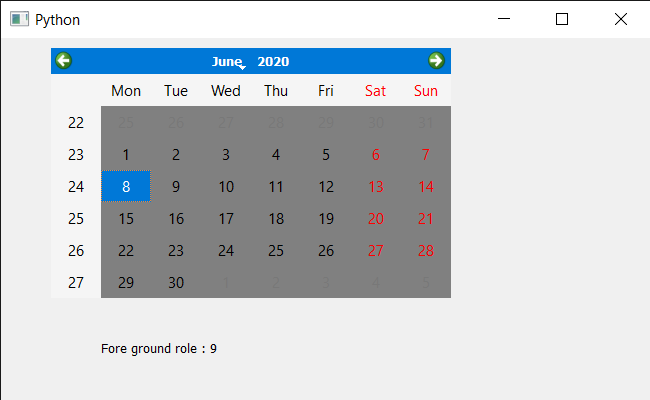En este artículo, veremos cómo podemos obtener el rol de primer plano de QCalendarWidget. Básicamente, hay dos tipos de roles en el calendario, uno en primer plano y el otro en segundo plano. La función de primer plano define el color de la paleta del calendario que se utiliza para dibujar el primer plano. Si no se establece un rol de primer plano explícito, el primer plano devuelve un rol que contrasta con el rol de fondo. Podemos establecer el rol de primer plano con la ayuda del método setForegroundRole.
Para hacer esto, usaremos el método de primer plano con el objeto QCalendarWidget.
Sintaxis: calendar.foregroundRole()
Argumento: No toma ningún argumento
Retorno: Devuelve el objeto QPalette.ColorRole pero cuando se imprime muestra el valor asociado con el rol
A continuación se muestra la implementación.
Python3
# importing libraries
from PyQt5.QtWidgets import *
from PyQt5 import QtCore, QtGui
from PyQt5.QtGui import *
from PyQt5.QtCore import *
import sys
class Window(QMainWindow):
def __init__(self):
super().__init__()
# setting title
self.setWindowTitle("Python ")
# setting geometry
self.setGeometry(100, 100, 650, 400)
# calling method
self.UiComponents()
# showing all the widgets
self.show()
# method for components
def UiComponents(self):
# creating a QCalendarWidget object
self.calendar = QCalendarWidget(self)
# setting geometry to the calendar
self.calendar.setGeometry(50, 10, 400, 250)
# setting cursor
self.calendar.setCursor(Qt.PointingHandCursor)
# setting foreground role
self.calendar.setForegroundRole(QPalette.Base)
# getting palette and setting color to the background to it
p = self.calendar.palette()
p.setColor(self.calendar.foregroundRole(), Qt.darkGray)
self.calendar.setPalette(p)
# creating label to show the properties
self.label = QLabel(self)
# setting geometry to the label
self.label.setGeometry(100, 280, 250, 60)
# making label multi line
self.label.setWordWrap(True)
# getting foreground role
value = self.calendar.foregroundRole()
# setting text to the label
self.label.setText("Fore ground role : " + str(value))
# create pyqt5 app
App = QApplication(sys.argv)
# create the instance of our Window
window = Window()
# start the app
sys.exit(App.exec())
Producción :

Publicación traducida automáticamente
Artículo escrito por rakshitarora y traducido por Barcelona Geeks. The original can be accessed here. Licence: CCBY-SA